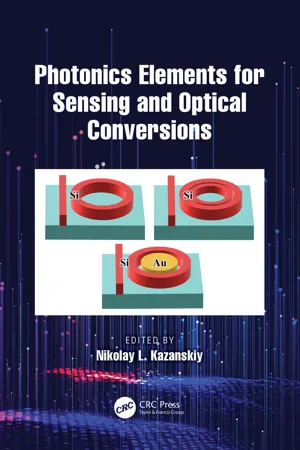
- 300 pages
- English
- ePUB (mobile friendly)
- Available on iOS & Android
Photonics Elements for Sensing and Optical Conversions
About This Book
This book covers a number of a rapidly growing areas of knowledge that may be termed as diffractive nanophotonics. It also discusses in detail photonic components that may find uses in sensorics and optical transformations. Photonics Elements for Sensing and Optical Conversions, covers a number of rapidly growing areas of knowledge that may be termed as diffractive nanophotonics. The book examines the advances in computational electrodynamics and nanoelectronics that have made it possible to design and manufacture novel types of photonic components and devices boasting unique properties unattainable in the realm of classical optics. The authors discuss plasmonic sensors, and new types of wavefront sensors and nanolasers that are widely used in telecommunications, quantum informatics and optical transformations. The book also deals with the recent advances in the plasmonic sensors based on metal-insulator-metal waveguides for biochemical sensing applications. Additionally, nanolasers are examined in detail, with a focus on contemporary issues, the book also deals with the fundamentals and highly attractive applications of metamaterials and metasurfaces. The authors provide an insight into sensors based on Zernike optical decomposition using a multi-order diffractive optical element, and explore the performance advances that can be achieved with optical computing. The book is written for opticians, scientists and researchers who are interested in an interesting section of plasmonic sensors, new types of wavefront sensors and nanolasers, and optical transformations. The book will be bought by upper graduate and graduate level students looking to specialize in photonics and optics.
Frequently asked questions
Information
Table of contents
- Cover Page
- Half-Title Page
- Title Page
- Copyright Page
- Contents
- Preface
- About the Author
- List of Abbreviations
- Chapter 1 Silicon Photonic Waveguides: Comparison and Utilization in Sensing Applications
- Chapter 2 Photonic Crystal Cavities in Integrated On-Chip Optical Signal Processing Components
- Chapter 3 Nanoplasmonic Sensors: Recent Advances
- Chapter 4 Plasmonic Nanolasers
- Chapter 5 Metasurfaces and Several Well-Studied Applications
- Chapter 6 Optical Fiber Sensors Based on Diffractive and Fiber Periodic Microstructures
- Chapter 7 Wave Front Aberration Sensors Based on Optical Expansion by the Zernike Basis
- Chapter 8 Optical Computing: Key Problems, Achievements, and Perspectives
- General Conclusion
- Appendix A: Listing for Calculating the Sensor Matched with the Zernike Basis Functions
- Appendix B: Listing for Calculating a Distorted Image
- Index